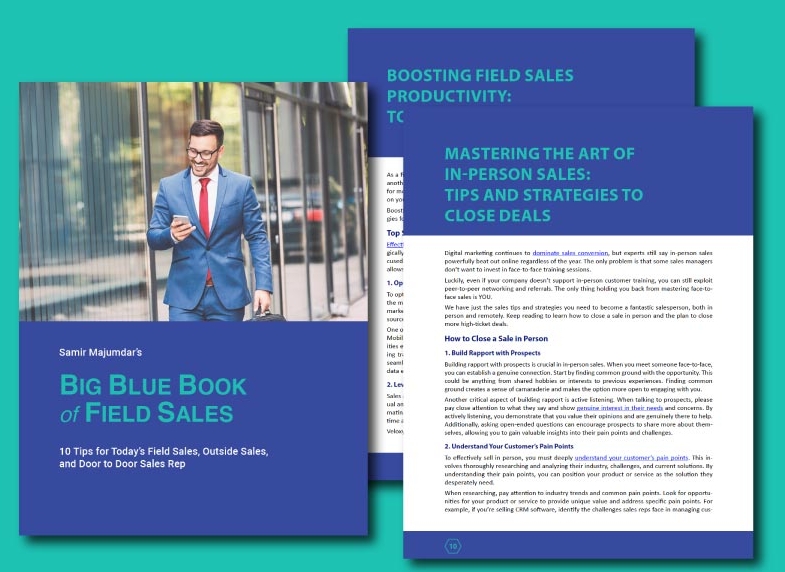
Best Mobile CRM Apps to Boost Your Sales Productivity
Did you know that using mobile CRM apps can boost sales productivity by 14.6%? So that’s a no-brainer, right? It’s time for you and your sales team to embrace these apps! But what are your best options in 2024? Today I’m breaking down my top recommendations for the best mobile CRM apps. I’ll look into how these mobile CRM tools can
























Before the pandemic, Salesforce found that most customers were demanding a team selling approach to satisfying their needs.
Fast forward to today’s post-pandemic business world, and our research shows that sales teams are starting to put the customer experience first—and team (or collaborative) selling is an integral part of that sales plan.
What better way to satisfy the rising standards of customers than by inviting more trusted advisors from other departments into the sales process, such as marketing, product development, customer service, and even the C-suite.
Start delivering more value-add to customer engagement today by reading the following guide to team selling in a post-COVID business world.
Ebook: Field Sales Report
Get your hands on all of the data, timely insights, and applicable takeaways.
Webinar: Field Sales Report
Attend the webinar where two special guests review the findings and offer advice.
What is Team Selling?
Team selling is when a salesperson invites other company stakeholders into the sales process. These stakeholders can often include personnel from marketing, manufacturing, operations, and other departments that traditionally are not customer facing.
The purpose of team selling is three fold.
First, the added team members offer unique advice that would otherwise not be delivered by the salesperson
Second, team selling helps the customer feel more valued and their interests more prioritized.
Third, collaborative confidently shortens and accelerates the sales cycle.
There’s no part of the sales funnel where team selling doesn’t work. Inviting other team members into cold outreach can help generate more leads at the top of the funnel just as much as having more team members upsell and cross sell at the bottom of the funnel can help generate more sales.
Team Selling: Why it works for field sales
When you’re out of the office three weeks out of four, having a collaborative team of personnel involve themselves in the sales process can prevent your leads from going cold.
There’s two key reasons why team selling is especially useful to field sales representatives.
For one, team selling helps add significant personalization to customer engagement. Inviting more stakeholders to advise customers not only makes the customer feel more prioritized, but it gives the field rep new insights and perspectives on how to personalize outreach and best close the deal.
And second, team selling can generate a powerful competitive advantage when your proposal is being compared to those of your competitors. If the majority of the competing proposals are being managed by a single sales rep, you immediately gain the upper hand no matter the difference in price or product.
Be sure to add team selling to your field sales team today!
Team Selling: Why it works for inside sales
When you’re the predominant leader of cold outreach, you can use all of the help you can get to warm your calls and emails. This is especially true for account based selling, when other departments have just as much at stake in creating leads and opps as the inside sales rep.
Here are two other reasons why team selling is vital for inside sales.
First, team selling improves your perceived expertise and authority. Inside sales teams that rely exclusively on their SDRs to generate awareness have a much lower success rate than inside sales teams that leverage team selling. Automated emails from the C-suite or product management have been found to build significant trust alongside emails from SDRs.
Second, team selling builds stronger relationships across the company. Field sales is known for having quality, long-standing relationships with engineering, customer service, and other departments, whereas inside sales can be left on their own and often perceived as an extension of marketing. By integrating inside sales with other departments, SDRs can gain better access to the right information and be perceived as a more integral part of the company’s success.
Team Selling and Personal Selling: What’s the difference?
What is personal selling? Well, it’s a sales process managed from beginning to end by a single sales representative. Companies that rely on this traditional approach have far less success than companies that lead with team selling.
In addition to more revenue, sales teams that incorporate team selling have much higher morale, optimism, and overall sales productivity.
Whereas personal selling keeps the rep’s morale tied directly to their manager, team selling extends the rep’s morale across several stakeholders. This builds their confidence and prevents micro-management.
Salespeople working in team selling environments are also more optimistic. Because they’re working with a variety of other specialists on closing a deal, more creativity and problem solving is usually applied to the sales process because of the range of perspectives and skillsets.
Sales productivity is a key performance indicator for salespeople. The less roadblocks and question marks a salesperson has during the sales process, the faster the sales cycle. This is mainly due to the fact that sales reps can seamlessly share customer intelligence, KPIs, and technology with other departments, which is unheard of in personal selling.
How to Implement Team Selling in Salesforce
If you’re ready to implement team selling and you already use Salesforce—you’re already ahead of the game!
Salesforce is the most powerful, yet sometimes most intimidating CRM on the planet. When a sales team is preparing to deploy a team selling program, they should start and end with the involvement of their Salesforce instance.
Lucky for you we’ve been Salesforce partners since 2015. We put together this quick and easy 3-step roadmap on implementing team selling in Salesforce.
1. Enable Team Selling
If you’re using Enterprise or higher, helping your reps practice team selling starts with three settings. First, find Opportunity Team Settings in the Quick Find box. Then, select Enable Team Selling. And lastly, choose the opportunity page layouts where you want to add the Opportunity Team Member related list. That’s it!
2. Clearly Define Roles
You’ll also want to set every Salesforce user’s role. You do this by using Sales Cloud’s Account Team feature.
The Account Team feature will help each member of the team selling program know their defined responsibilities and how their performance will be measured. It will also unlock access to a wide range of sales intelligence and reporting that would otherwise be siloed and held by other departments.
If you’re worried that team selling in Salesforce will get out of hand, don’t worry! Salesforce puts limits on how many members can be on a team, keeping communications and accountability hyper-focused.
3. Review Sales Tech Stack
If you’ve read our popular Strategic Five Report, you’ll recall that mismatched technology stacks can inhibit team selling. This is especially true for Salesforce deployments.
It’s far too common for tech stacks to get out of control across an enterprise. For example, Sales may use Adobe for e-signatures, but Human Resources may use DocuSign. To keep your sales process streamlined, you should review your tech stack based on each tool’s integration with Salesforce (and don’t forget a field sales tool!).
I’ll go a step further and recommend that every solution that is planned to be used in team selling has a five-star, long-standing presence on the Salesforce AppExchange. When your team selling program is centralized, the chances for roadblocks and slow-downs is near eliminated.
If you’re not using AppExchange apps, start here: Getting started with AppExchange
Rebuild Morale Post-COVID with Team Selling!
What’s your favorite team sport?
My favorite team sport is Soccer. I actually play in a league out here in Silicon Valley. There is a certain thrill you get when you participate in a big game-changing play. I assisted on a goal this past weekend, and you couldn’t wipe the smile off of my face.
Team selling is synonymous with team sports. If you want to win, you have to involve your teammates, leverage their unique strengths, and build chemistry that your competition does not have.
Would you like a demonstration on how to use team selling in Salesforce? Request a demo with today!
And if you enjoyed this read, you’d also find value with the following sales blog posts: